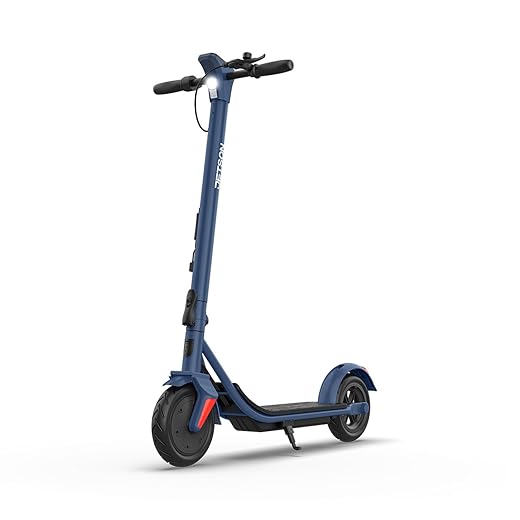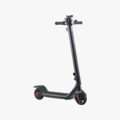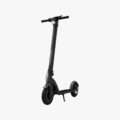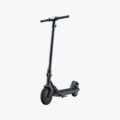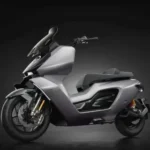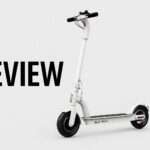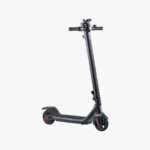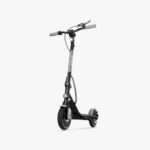- Home
- Scooters
- Electric Scooters
- Jetson Shield
Jetson Shield
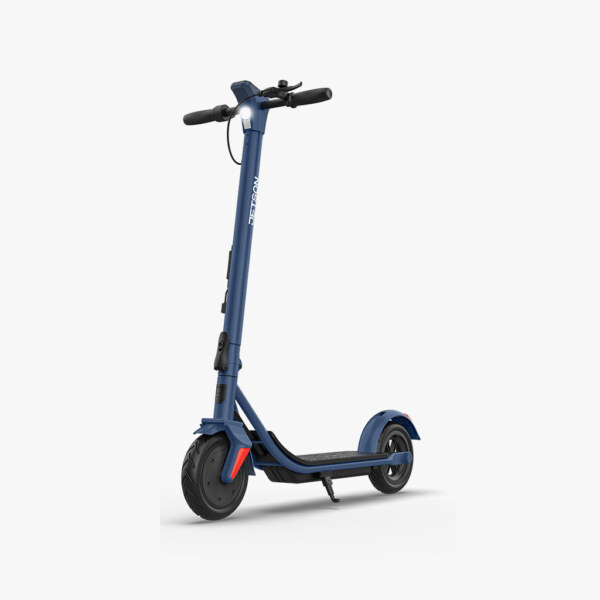

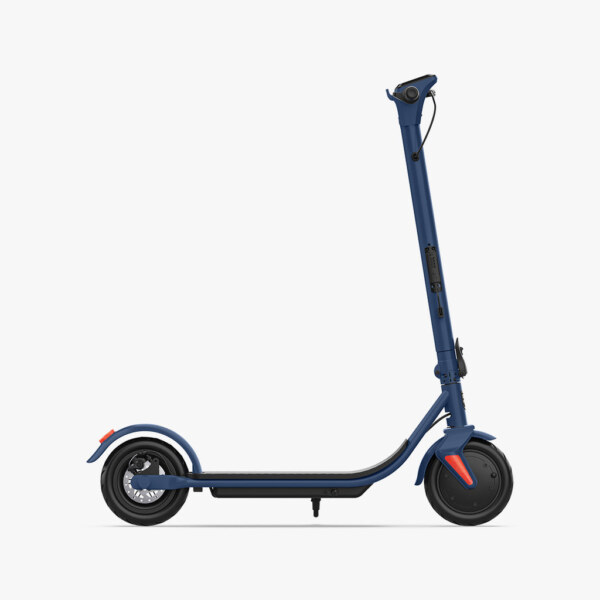
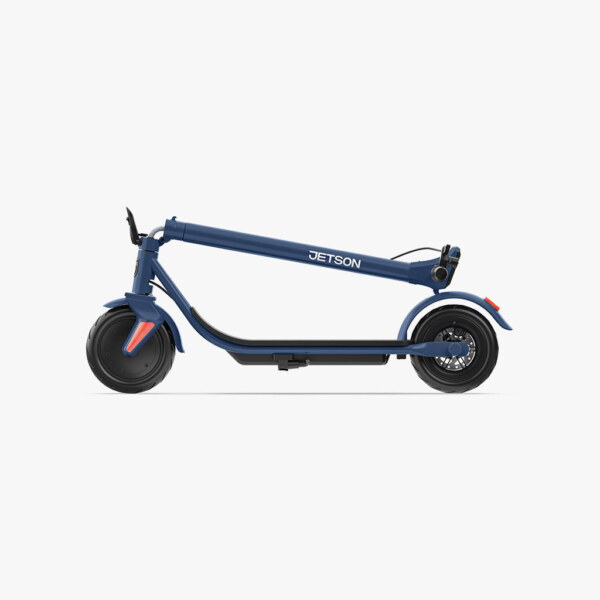
- Battery Range: 18 miles (29 km)
- Top Speed: 15.5 mph (25 km/h)
- Motor Power: 350 W
- Weight Capacity: 265 lb (120 kg)
- Charging Time: ≈5–6 h
- Scooter Weight: 44.0 lb (20.0 kg)
PROS
- 15.5 mph (25 km/h) top speed
- 18 miles (29 km) stated range
- 8.5 in pneumatic tires
- Front & rear suspension
- Triple security: cable lock, electronic lock, tracker slot
- LCD display
CONS
- Heavy to carry
- Range is modest for weight
- Regenerative braking not specified
Key Takeaways
- The Jetson Shield is a compact electric scooter ideal for students and commuters, providing built-in security features.
- It reaches speeds of 15.5 mph, supports riders up to 265 lb, and uses a 350 W rear hub motor for power.
- The scooter includes a retractable cable lock, electronic lock, and a compartment for a Bluetooth tracker, enhancing security.
- With simple controls, three riding modes, and a battery range of up to 18 miles, it suits daily city commutes.
- However, it’s not for riders seeking high speeds or rough terrain, making it perfect for calm urban riding.
Table of contents
- What Is the Jetson Shield?
- How the Jetson Shield Works
- Key Specifications
- Design & Build Quality
- Performance Fundamentals
- Battery, Range & Efficiency
- Ride Quality & Comfort
- Braking & Safety Features
- Portability & Daily Usability
- Maintenance & Care
- Weather & Seasonal Considerations
- Jetson Shield vs Alternatives
- Who the Jetson Shield Is (and Isn’t) For
The Jetson Shield is a compact electric scooter built around real-world city use. It feels simple, solid, and a bit overprotective in a good way. It suits riders who park in public spaces, ride short to medium distances, and want fewer worries about theft. So it fits students, everyday commuters, and first-time owners who like clear controls and extra security without drama.
What Is the Jetson Shield?
The Jetson Shield is an adult and teen electric scooter with a 350 W rear hub motor, 36 V system, and built-in security features. It reaches about 15.5 mph (25 km/h) under normal conditions and supports riders up to 265 lb (120 kg). The stem folds down, hooks to the rear, and the whole setup slides into a trunk, hallway corner, or under a desk.
The core idea sits in the name. The scooter packs a retractable cable lock in the stem, an electronic lock that uses NFC tags or a passcode, and a hidden compartment sized for a Bluetooth tracker. So you roll up, lock it with what it already has, and walk away with less gear to carry.
For people who ride on pavement, deal with modest hills, and want a calm, practical machine instead of a hot-rod, the Jetson Shield works as a secure point-to-point tool.
How the Jetson Shield Works
The Jetson Shield uses a rear hub motor tucked inside the back wheel. Press the thumb throttle on the right, the controller feeds power from the 36 V battery, and the scooter starts to pull. There is no chain or belt, so drive noise stays low and maintenance stays simple.
Three riding modes shape how it responds. Low modes keep speed and punch down for crowded paths or new riders. The highest mode lets it climb to its rated top speed. So you can match the behavior to the street, not the other way around. Cruise control kicks in after holding a steady pace for a short stretch. Then the scooter keeps that speed until you tap the brake or throttle.
The battery pack sits inside the deck and connects to an external charging port. A full charge from low takes about 6 hours. So overnight charging, or a full workday at the outlet, lines up well with daily routines.
Braking comes from a rear mechanical disc on the left lever. During rides that brake does the real work. When you park, the electronic lock can block wheel movement, and the cable lock lets you attach the scooter to a fixed object. The hidden compartment holds a tracker so you can trace the scooter if someone moves it. Together those pieces feel practical, not gimmicky.
The cockpit stays clear. Throttle and buttons on the right, brake lever on the left, display in the center with speed, mode, and lock info. So most riders feel at home after a couple of minutes.
Key Specifications
These core numbers outline what you actually get out of the box. They keep the Jetson Shield in a clear, commuter-focused class.
General
| Item | Value |
|---|---|
| Model | Jetson Shield Ultra-Lock Electric Scooter |
| Type | Adult / teen electric scooter |
| Recommended Age | 12+ |
| Max Rider Weight | 265 lb (120 kg) |
| Scooter Weight | 39.2 lb (17.8 kg) |
| Intended Use | Urban and suburban paved riding |
Performance & Power
| Item | Value |
|---|---|
| Motor | 350 W rear hub |
| Top Speed | 15.5 mph (25 km/h) |
| Speed Modes | 3 selectable modes |
| Drive | Rear wheel, direct electric |
Battery, Charging & Electrical
| Item | Value |
|---|---|
| Battery Type | Lithium-ion |
| Battery Rating | 36 V, 7.5 Ah (270 Wh) |
| Claimed Range | Up to 18 mi (29 km) |
| Charging Time | About 6 hours |
| Charger Type | AC charger, external port |
| Display | LED / LCD screen with controls |
Build & Dimensions
| Item | Value |
|---|---|
| Frame Material | Alloy |
| Wheel Size | 8.5 in (216 mm) |
| Tire Type | Pneumatic (air-filled) |
| Deck Length x Width | 22.3 x 6.2 in (56.6 x 15.7 cm) |
| Unfolded (L x W x H) | 42.9 x 19.2 x 45.5 in (109 x 49 x 116 cm) |
| Folded (L x W x H) | 42.9 x 19.2 x 18.5 in (109 x 49 x 47 cm) |
| Kickstand | Yes |
Safety & Control
| Item | Value |
|---|---|
| Braking | Rear mechanical disc |
| Lights | Front LED, rear / brake light |
| Audible Alert | Bell |
| Speed Modes | 3, from handlebar display |
| Integrated Security | Electronic lock, cable lock, tracker bay |
Features & Extras
| Item | Value |
|---|---|
| Triple-lock Security | Yes |
| Cruise Control | Yes |
| Foldable Stem | Yes |
| NFC Security Tags | Included |
| Hidden Tracker Compartment | Fits compact tracker devices |
Warranty & Compliance
| Item | Value |
|---|---|
| Warranty | 180-day limited warranty |
| Compliance | Follow local e-mobility rules |
Design & Build Quality
The Jetson Shield looks clean and straightforward at first glance. The folding stem hinges near the deck and locks into the rear fender when folded. So when you pick it up, it feels like one piece, not a loose bundle.
The alloy frame feels solid for this class. Welds look tidy, and cables sit close to the stem instead of hanging out to catch on things. That detail matters once you start dragging it through bike racks, hall doors, or train doors.
The deck has a rubber surface with enough space for a natural staggered stance. Most riders stand with one foot forward, one back, and stay fully on the deck. Ground clearance is moderate, so you gain a planted feel without scraping on normal curbs if you ride with a bit of care.
The integrated security hardware shapes the look in a smart way. The cable lock disappears into the stem. The electronic lock sits inside the display system. The tracker compartment hides in the body. So nothing clanks around, and the scooter keeps a clean profile even with all that hardware inside.
Performance Fundamentals
Out on the path the Jetson Shield feels calm and predictable. The 350 W rear hub pulls smoothly once you kick off and press the throttle. Power comes in gradually, so balance stays easy for new riders.
On flat ground it reaches its rated top speed with an average adult. Then it holds that pace in top mode without feeling nervous. The rear motor placement helps traction on takeoff and light climbs, so the tire hooks up instead of spinning.
On grades around 7 percent the scooter still climbs, just at a lower pace. On longer hills around 10 percent, speed drops more, and some riders will add a few kicks. That behavior lines up with its role as a compact commuter, not a heavy hill climber.
Straight line stability at full speed is solid. The steering is responsive but not twitchy. So flowing through bike lanes, park paths, and side streets feels natural once you get used to the bar width and weight.
Battery, Range & Efficiency
The 36 V, 7.5 Ah pack carries a claimed 18 mi (29 km) range. That number comes from light riders, smooth pavement, low to medium speeds, and warm weather. Real rides look different.
In daily use a lighter rider on mostly flat routes, mixing modes and not pinning full speed every second, can come close to the upper part of that claim. A heavier rider, colder mornings, hills, headwinds, and constant top speed pull that number down. So it makes sense to treat the listed range as a high end, not a promise.
A few habits help the battery and keep range steady over time.
Keep the pack from sitting near empty for long periods. Let the scooter cool to room temperature before charging after hard rides. Store it indoors, away from heat or freezing floors. For longer breaks keep the charge in the middle to high band and top up every month or two. With that rhythm, the Jetson Shield serves well as a day-to-day city ride instead of a once-a-week toy.
Ride Quality & Comfort
Ride feel leans on those 8.5 in pneumatic tires. There is no suspension, so the air in the tires does most of the work. On clean pavement, tiles, and small cracks, the scooter feels stable and not harsh. On broken asphalt, deep potholes, and cobbles, it starts to feel busy, so you pick better lines and ease off the speed.
Bar width gives decent leverage for steering without making it awkward in tight spaces. Stem height fits most of the target riders. When the fold latch stays snug, stem flex stays low at this speed range.
The deck’s rubber grip holds shoes in place in dry conditions. In damp weather it still helps, though you need to clean mud or dust off your soles now and then. The thumb throttle has a gentle ramp, and the brake lever makes it easy to pick how hard you slow. So even small mistakes on the controls feel forgiving.
Overall comfort matches short to mid-length commutes, campus crossings, and casual evening rides.
Braking & Safety Features
The rear mechanical disc brake handles normal stops. Lever feel starts early, then firms up as you pull. So you get enough feedback to trail off smoothly or stop harder when a car pulls out or a pedestrian drifts across.
Lighting is built in. The front LED makes the scooter visible and lights up paths at legal speeds on familiar streets. The rear light, with brake function, alerts people behind you when you slow down. Extra reflective gear still helps in dark traffic, yet the stock setup covers the basics.
Then the safety story continues with parking protection.
- The retractable cable lock lets you tie the scooter to racks or rails.
- The electronic lock blocks the wheel until you unlock with NFC or passcode.
- The hidden bay holds a tracker so you can trace the scooter if needed.
This stack raises the effort for casual theft and helps you keep the scooter in sight digitally. Smart parking spots and clear lock-up habits still matter and pair well with these tools.
Water information stays limited, so treat the Shield as splash tolerant, not a rain scooter. Avoid deep puddles, strong showers, and wash the scooter gently instead of blasting it.
Portability & Daily Usability
At 39.2 lb (17.8 kg) the Jetson Shield feels sturdy in the hand. Short carries up a few steps, onto a train, or through a lobby stay realistic. Carrying it several floors every day feels less fun, so apartment riders may notice the weight.
The fold is quick. Release, lower, hook. Then the scooter turns into a compact, flat package that fits into car trunks, office corners, or next to a wall at home. The kickstand is stable enough for daily parking without hunting for the perfect spot.
For daily life, the integrated locks save time. You stop, lock with what is built in, tap the code, and go. So there is less clutter on the bars, less metal in your backpack, and fewer excuses to leave it unlocked “just for a minute”.
Maintenance & Care
A simple routine keeps the Jetson Shield running well and avoids surprises.
After every few rides:
- Check tire pressure against the sidewall numbers.
- Listen for new rattles, especially near the folding joint.
Weekly or around every 50–60 miles:
- Inspect tires for cuts, embedded stones, or flat spots.
- Test braking in a safe area. If the lever gets long or soft, adjust cable tension.
- Check the hinge and latch for play. Tighten hardware as needed.
- Make sure lights, display, and lock functions still work.
Monthly:
- Go over visible bolts on the stem, handlebar clamp, deck plates, and brake mount.
- Inspect the retractable cable for wear or fraying.
- Test both NFC unlock and passcode unlock.
Cleaning:
- Wipe frame, deck, and wheels with a damp cloth, then dry them.
- Keep strong water streams and harsh chemicals away from electronics and bearings.
Storage:
- Keep it indoors where possible.
- Avoid leaving it with a dead battery for weeks.
- For long breaks, hold a mid to high charge and refresh now and then.
This pattern feels normal once you repeat it a few times. Then you catch small issues early and keep the ride safe.
Weather & Seasonal Considerations
The Jetson Shield feels most at home on dry pavement. With limited data on deep water sealing, riders stay cautious in rough weather.
On wet streets or light drizzle:
- Drop speed, since braking distance grows.
- Use smoother pulls on the rear brake.
- Steer around metal plates, paint, and wet leaves, which turn slick fast.
In hot weather:
- Avoid parking for hours in direct sun or closed cars.
- Let the scooter cool a bit indoors before charging after a hard ride.
In cold weather:
- Expect less range from the battery.
- Store the scooter somewhere warmer between rides.
- Let it warm to room temperature before charging.
Snow, ice, deep puddles, and thick mud sit outside the Shield’s job. Riding in that mix strains grip and hardware, so keeping it for clear streets pays off.
Jetson Shield vs Alternatives
Inside the 15–16 mph commuter class, many scooters look similar on paper. Same wheel size, close motor ratings, similar weight limits. Jetson Shield leans into security and everyday honesty instead of chasing bigger numbers.
Where the Jetson Shield stands out:
- Triple integrated security that stays with the scooter.
- Clean bars and stem with no bolt-on lock brackets.
- Simple controls, speed modes, and cruise that match real commuting.
Where typical rivals hold an edge:
- Larger batteries for longer round trips.
- Front plus rear braking systems on some models.
- Lighter frames for riders who carry their scooter many floors every day.
If you want a more playful feel with sporty posture, the Jetson Racer sits in a different corner of the lineup. If you like a clean, classic commuter style with a simpler feature set, the Jetson Eris offers another path. Against those, the Shield leans hardest into built-in security for everyday locking and city parking.
Mid-tier and sport scooters beat the Shield on speed, hill pull, and comfort over rough ground. They also add weight, cost, and complexity, and they rarely match its built-in lock setup. So the choice comes down to route length, terrain, and how often you park in places that make you uneasy.
Who the Jetson Shield Is (and Isn’t) For
The Jetson Shield is for riders who:
- Commute short or medium distances on smooth pavement.
- Prefer a calm top speed that feels under control.
- Park in public spaces and want strong built-in theft deterrents.
- Like scooters that feel simple to pick up and simple to live with.
- Appreciate real tires and a stable deck in a compact frame.
Good matches include:
- Students locking up outside dorms, classrooms, and libraries.
- City riders going from home to transit stops to office and back.
- Workers who share bike racks and want quick lock-and-go routines.
- First-time scooter owners who want less setup and more confidence.
The Jetson Shield is not for riders who:
- Want more than 15.5 mph (25 km/h) and hard acceleration.
- Need wide day-long range far above its practical window.
- Ride long, steep hills on every trip.
- Use rough trails, gravel, or broken streets that call for suspension and big tires.
- Carry a scooter many floors every single day and want something ultra light.
For its lane, the Jetson Shield lands as a friendly, secure city scooter. It trades flashy numbers for stable power, clear handling, and built-in locks that match how people actually park and ride. So it feels like a tool you keep reaching for, which is the point.
Specifications
General
| Model The Model specifies the exact version or name of the scooter. It helps identify its unique design, features, and specifications within the manufacturer’s product line. Knowing the model makes it easier to compare options, find compatible accessories, or look up support information. | Shield |
| Brand The Brand identifies the manufacturer or company that designs and produces the scooter. A trusted brand is a sign of quality, reliability, and good customer support. Well-known brands often have higher standards for safety, performance, and after-sales service, giving you more confidence in your purchase. | Jetson |
| Release Date The Release Date indicates when the scooter model was officially launched on the market. This helps you know how current the design, technology, and features are. A newer release date often means updated components, improved performance, and the latest safety or smart features. | 18 November 2025 |
| Recommended Age Recommended Age indicates the minimum age range that the scooter is designed for, based on safety, size, and ease of use. Following the recommended age helps ensure that riders can handle the scooter’s speed, weight, and controls comfortably and safely. Always check local laws and use protective gear, especially for younger riders. | 12+ |
Performance & Power
| Motor Power (Wattage) What it means: The motor power, measured in watts (W), shows how strong the scooter’s electric motor is. Why it matters: Higher wattage usually means better acceleration, more torque, and improved performance on hills or rough terrain. For example, a 250W motor is good for flat city roads and light riders, while a 500W or 1000W motor provides more power for faster speeds or climbing steep inclines. | 350 W hub motor |
| Top Speed The Top Speed indicates the maximum speed that the scooter can reach under optimal conditions. It’s usually measured on level ground with a fully charged battery and an average rider weight. A higher top speed allows you to travel longer distances faster, but always ensure you ride within legal speed limits and your personal comfort zone for safety. | 15.5 mph (25 km/h) |
| Battery Capacity Battery Capacity refers to the total amount of energy the scooter’s battery can store, usually measured in ampere-hours (Ah) or watt-hours (Wh). A higher battery capacity means you can ride longer distances on a single charge, reducing the need for frequent recharging. Keep in mind that actual range can vary depending on rider weight, terrain, speed, and weather conditions. | 36 V 7.5 Ah (270 Wh) |
| Estimated Range per Charge The Estimated Range per Charge indicates the average distance the scooter can travel on a single full battery charge. This range is calculated under optimal conditions, such as flat terrain, moderate speed, and average rider weight. Real-world range may vary depending on riding style, terrain, weather, and load. A longer range means fewer recharges and greater freedom for longer trips. | 18 miles (29 km) |
| Hill Climb Ability Hill Climb Ability describes the maximum incline or slope that the scooter can handle while maintaining stable performance. It’s typically expressed as a percentage or in degrees. A higher hill climb rating means the scooter can tackle steeper hills without losing too much speed or power. Actual climbing performance may vary based on rider weight, battery charge, and terrain conditions. | Not specified |
| Drive System The Drive System refers to how power from the motor is delivered to the wheels. Electric scooters typically use either a hub motor (directly integrated into the wheel) or a chain/belt drive system. A high-quality drive system ensures smooth acceleration, efficient power transfer, and low maintenance. The choice of drive system affects performance, noise level, and overall ride experience. | Not specified |
Charging & Electrical
| Charging Time Charging Time indicates how long it takes to fully recharge the scooter’s battery from empty to 100% using the standard charger provided. Faster charging means less downtime and more time on the road. Actual charging time may vary slightly depending on battery capacity, charger output, and environmental conditions. | Approx. 5–6 h |
| Battery Type Battery Type refers to the specific technology used in the scooter’s battery, which affects performance, lifespan, weight, and charging time. Most modern electric scooters use high-quality lithium-ion (Li-ion) batteries because they offer a good balance of energy density, durability, and low maintenance. A reliable battery type ensures consistent power delivery and longer riding ranges. | Lithium-ion battery |
| Removable Battery A Removable Battery means the battery pack can be easily detached from the scooter for convenient charging and replacement. This feature allows you to charge the battery separately, swap it with a spare for extended range, or securely store it indoors in extreme weather. Removable batteries add flexibility and make it easier to keep your scooter powered up wherever you are. | Non-removable internal battery (fixed pack) |
| Regenerative Braking Regenerative Braking is an energy-saving feature that converts some of the energy normally lost during braking back into battery power. When you slow down or brake, the motor works in reverse to generate electricity, which helps extend the scooter’s range and improves overall efficiency. This system also reduces wear on traditional brake components, leading to lower maintenance over time. | Not specified |
| Lighting Lighting refers to the built-in front and rear lights that enhance visibility and safety when riding in low-light conditions or at night. Good lighting helps you see the road ahead and ensures that other road users can see you. Many scooters include LED headlights, taillights, and sometimes brake lights or side reflectors for added safety and compliance with local traffic regulations. | LED headlight + rear LED light |
Build & Dimensions
| Scooter Weight Scooter Weight refers to the total weight of the scooter when fully assembled, including the battery. This affects how easy it is to carry, lift, and store the scooter when not in use. A lighter scooter is more portable and convenient for commuting, especially if you need to carry it upstairs or onto public transport. Keep in mind that a sturdy frame and quality components may add to the weight but also contribute to better durability and ride stability. | 44.0 lb (20.0 kg) |
| Maximum Rider Weight Maximum Rider Weight indicates the highest rider weight that the scooter is designed to safely support while maintaining optimal performance and stability. Staying within this limit helps ensure reliable acceleration, braking, and climbing ability, and it protects the frame, suspension, and motor from excessive strain. Exceeding the recommended limit may reduce performance and increase wear on components. | 265 lb (120 kg) |
| Deck Size Deck Size refers to the dimensions of the scooter’s standing platform. A wider and longer deck provides more foot space, allowing you to stand comfortably and adjust your stance while riding. A well-sized deck improves balance and stability, especially on longer rides or at higher speeds. Compact decks, on the other hand, help keep the scooter lightweight and portable. | Sturdy commuter frame with dual suspension |
| Handlebar Height Handlebar Height refers to the distance from the deck to the handlebars, which affects your riding posture and comfort. An appropriate handlebar height helps you maintain good balance, reduces strain on your back and arms, and makes steering more comfortable. Some scooters have adjustable handlebars to fit riders of different heights, while others have a fixed height for a streamlined design. | Fixed |
| Folding Mechanism The Folding Mechanism describes how easily and securely the scooter can be folded for carrying and storage. A well-designed folding system lets you quickly collapse the scooter into a compact size, making it convenient to transport on public transit, store under a desk, or fit into a car trunk. Look for sturdy latches and safety locks to ensure the scooter stays firmly in place when folded or unfolded. | Half-folding stem latch |
| Dimensions Folded Dimensions indicate the size of the scooter when it’s fully folded. This measurement shows how much space the scooter will take up when stored or carried, making it easier to check if it will fit in your car trunk, under a desk, or in a closet. Compact folded dimensions are ideal for commuters who need to bring their scooter on public transport or store it in tight spaces. | Unfolded: 44.1 x 19.1 x 46.1 in | Folded: 44.1 x 19.1 x 20.5 in |
| Material Material refers to the primary construction materials used for the scooter’s frame and key components. High-quality materials like aircraft-grade aluminum, reinforced steel, or durable composites provide strength, stability, and a lighter overall weight. A sturdy material ensures the scooter can handle daily wear and tear while maintaining safety and performance. | Not specified |
Safety & Control
| Brake Type(s) Brake Type(s) describe the braking systems the scooter uses to help you slow down or stop safely. Common brake types include mechanical brakes (like drum or disc brakes), electronic brakes, and foot brakes. Many scooters combine multiple braking systems for added safety and shorter stopping distances. The type and quality of brakes affect your control, especially when riding at higher speeds or on slopes. | Electronic + rear disc |
| Suspension Suspension refers to the system that absorbs shocks and vibrations while riding, providing a smoother and more comfortable ride over uneven or rough surfaces. Scooters may have front suspension, rear suspension, or dual suspension for better shock absorption and stability. Good suspension helps reduce rider fatigue and improves control, especially when riding on bumpy roads or off-road paths. | Front & rear |
| Tire Type Tire Type refers to the kind of tires the scooter uses, which directly affects ride comfort, traction, and maintenance. Common types include solid (airless) tires, pneumatic (air-filled) tires, or hybrid options. Pneumatic tires offer better shock absorption and a smoother ride on rough surfaces, while solid tires are puncture-proof and require less upkeep. The right tire type helps ensure safe handling and a comfortable ride in different conditions. | Pneumatic 8.5″ |
| Tire Size Tire Size indicates the diameter and width of the scooter’s tires, which affect ride comfort, stability, and how well the scooter handles different terrains. Larger tires generally offer better shock absorption and a smoother ride over bumps and rough surfaces, while smaller tires keep the scooter lighter and more portable. Choosing the right tire size helps ensure a balance between agility and comfort. | 8.5-inch |
| Kickstand The Kickstand is a built-in stand that allows you to park your scooter upright when it’s not in use. A sturdy kickstand keeps the scooter stable and prevents it from tipping over, protecting it from scratches and damage. It also makes storing and accessing your scooter more convenient, whether you’re at home, work, or on the go. | Side kickstand |
| Water Resistance Rating Water Resistance Rating indicates how well the scooter is protected against water and moisture, usually shown as an IP (Ingress Protection) rating. This rating helps you understand whether the scooter can handle light rain, splashes, or wet roads without damage. While most scooters are not fully waterproof, a good water resistance rating adds peace of mind when riding in changing weather conditions. Always avoid deep puddles or submerging the scooter to protect its electrical components. | Not specified |
Features & Extras
| Display/Console The Display (or Console) shows important real-time information about your ride, helping you monitor your scooter’s status at a glance. Typical displays show speed, battery level, distance traveled, and riding mode. Some models also include additional features like Bluetooth connectivity, app integration, or backlighting for better visibility at night. A clear and easy-to-read display enhances safety and convenience on every trip. | LCD display with speed and battery |
| Ride Modes Ride Modes refer to the different speed and power settings you can choose to match your riding style or road conditions. Common modes include eco for maximum range and energy efficiency, standard for everyday balance, and sport or turbo for higher speed and stronger acceleration. Switching between ride modes allows you to customize performance, conserve battery, and ride safely in various environments. | 3 riding modes |
| Smart App Connectivity Smart App Connectivity lets you pair your scooter with a dedicated mobile app via Bluetooth. Using the app, you can monitor real-time ride stats like speed, battery level, and range, adjust settings such as ride modes or cruise control, lock the scooter for added security, and sometimes receive firmware updates. This feature adds convenience and allows you to personalize your riding experience right from your smartphone. | None |
| Anti-Theft System The Anti-Theft System helps protect your scooter from unauthorized use or theft. This feature can include built-in alarms, electronic motor locks, GPS tracking, or remote locking through a mobile app. A good anti-theft system provides peace of mind when parking your scooter in public spaces, adding an extra layer of security to safeguard your investment. | Built-in cable lock + electronic lock + tracker compartment |
| Cruise Control Cruise Control allows you to maintain a steady speed without continuously holding the throttle. This feature makes longer rides more comfortable by reducing hand fatigue and providing a smoother, more relaxed riding experience — especially on flat, open roads or bike lanes. For safety, cruise control can usually be easily activated or deactivated while riding. | Yes |
| Accessories Included Accessories Included lists the additional items that come with the scooter to enhance your riding experience and convenience. Common accessories may include a charger, kickstand, bell, lights, phone holder, or carrying strap. These extras add value by making your scooter safer, easier to use, and ready to ride straight out of the box. | Not specified |
Warranty & Compliance
| Warranty Period The Warranty Period indicates how long the manufacturer guarantees the scooter against defects in materials and workmanship under normal use. A good warranty provides peace of mind, showing the brand’s confidence in its product quality. Always check what parts are covered, such as the frame, battery, and motor, and follow the maintenance guidelines to keep your warranty valid. | 180 days |
| Certifications Certifications confirm that the scooter meets specific safety, quality, and environmental standards set by recognized organizations or regulatory bodies. Common certifications may include CE, RoHS, UL, or other local compliance marks, depending on your region. These certifications ensure that the scooter is manufactured to high standards and is safe and legal to use in your country. | Region-dependent |



